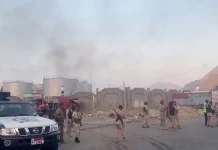
KARACHI: Nuclear-armed countries, including India and Pakistan, are increasing the size of their arsenals despite an overall decrease in the number of nuclear warheads, a Stockholm International Peace Research Institute (SIPRI) report has said.
The Sweden-based SIPRI launched its latest report, which assesses the current state of armaments, disarmament and international security.
The SIPRI governing board’s chairman, Ambassador Jan Eliasson, who is a former deputy secretary-general of the United Nations, said: “A key finding is that despite an overall decrease in the number of nuclear warheads in 2018, all nuclear weapon-possessing states continue to modernise their nuclear arsenals.”
At the beginning of this year, nine states — the United States, Russia, the United Kingdom, France, China, India, Pakistan, Israel and the Democratic People’s Republic of Korea (North Korea) — possessed approximately 13,865 nuclear weapons.
This marked a decrease from the approximately 14,465 nuclear weapons that SIPRI estimated these states possessed at the beginning of 2018.
Of these 13,865 nuclear weapons, 3,750 were deployed with operational forces and nearly 2,000 were kept in a state of high operational alert.
The nuclear arsenals of the other nuclear-armed states are considerably smaller, but all are either developing or deploying new weapon systems or have announced their intention to do so. China, India and Pakistan are increasing the size of their nuclear arsenals.
India and Pakistan, which have 130 to 140 and 150 to 160 nuclear warheads respectively, were also developing new systems, it said.
“India and Pakistan are expanding their military fissile material production capabilities on a scale that may lead to significant increases in the size of their nuclear weapon inventories over the next decade,” said Shannon Kile, director of the SIPRI Nuclear Arms Control Programme.
The decrease in the overall number of nuclear weapons in the world, it said, was due mainly to Russia and the US, which together still account for over 90 per cent of all nuclear weapons, further reducing their strategic nuclear forces pursuant to the implementation of the 2010 Treaty on Measures for the Further Reduction and Limitation of Strategic Offensive Arms (New START) while also making unilateral reductions.
In 2018, Russia and the US announced that they had achieved the final New START force reduction limits by the specified deadline.
Both Russia and the US have extensive and expensive programmes under way to replace and modernise their nuclear warheads, missile and aircraft delivery systems, and nuclear weapon production facilities.
In 2018, the US Department of Defence set out plans to develop new nuclear weapons and modify others to give them expanded military roles and missions.
North Korea continued to prioritise its military nuclear programme as a central element of its national security strategy, although in 2018 it announced a moratorium on the testing of nuclear weapons as well as medium- and long-range ballistic missile delivery systems. The availability of reliable information on the status of the nuclear arsenals and capabilities of the nuclear-armed states varies considerably.



